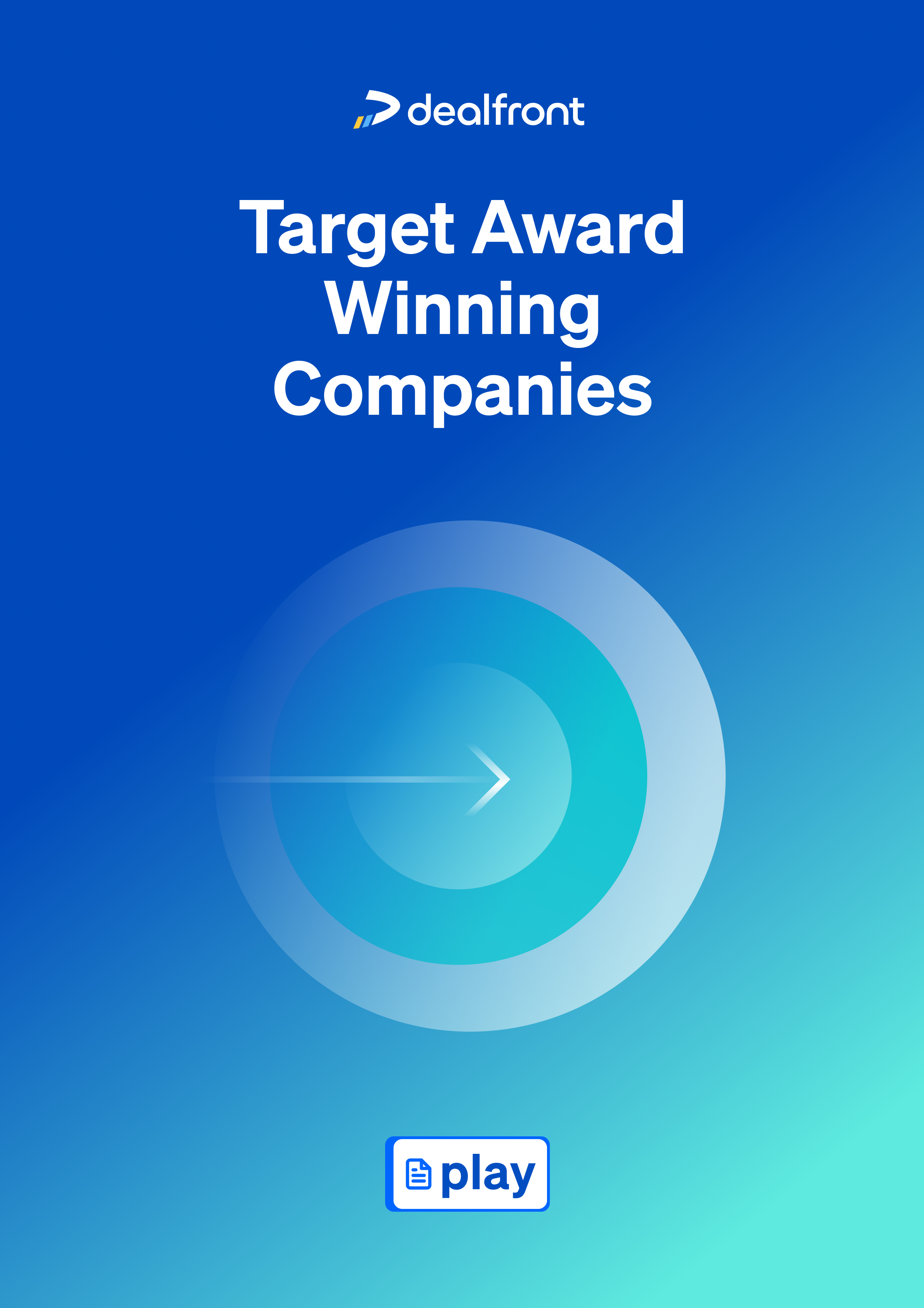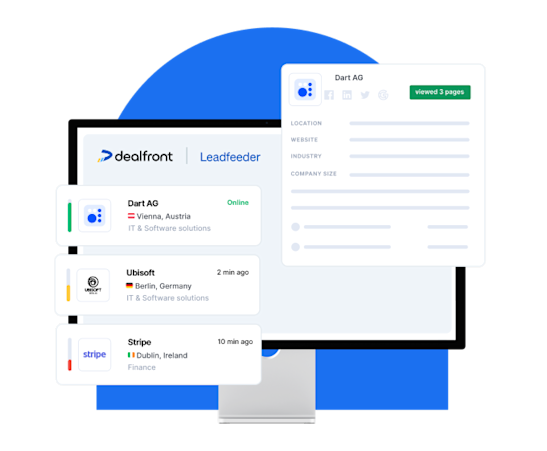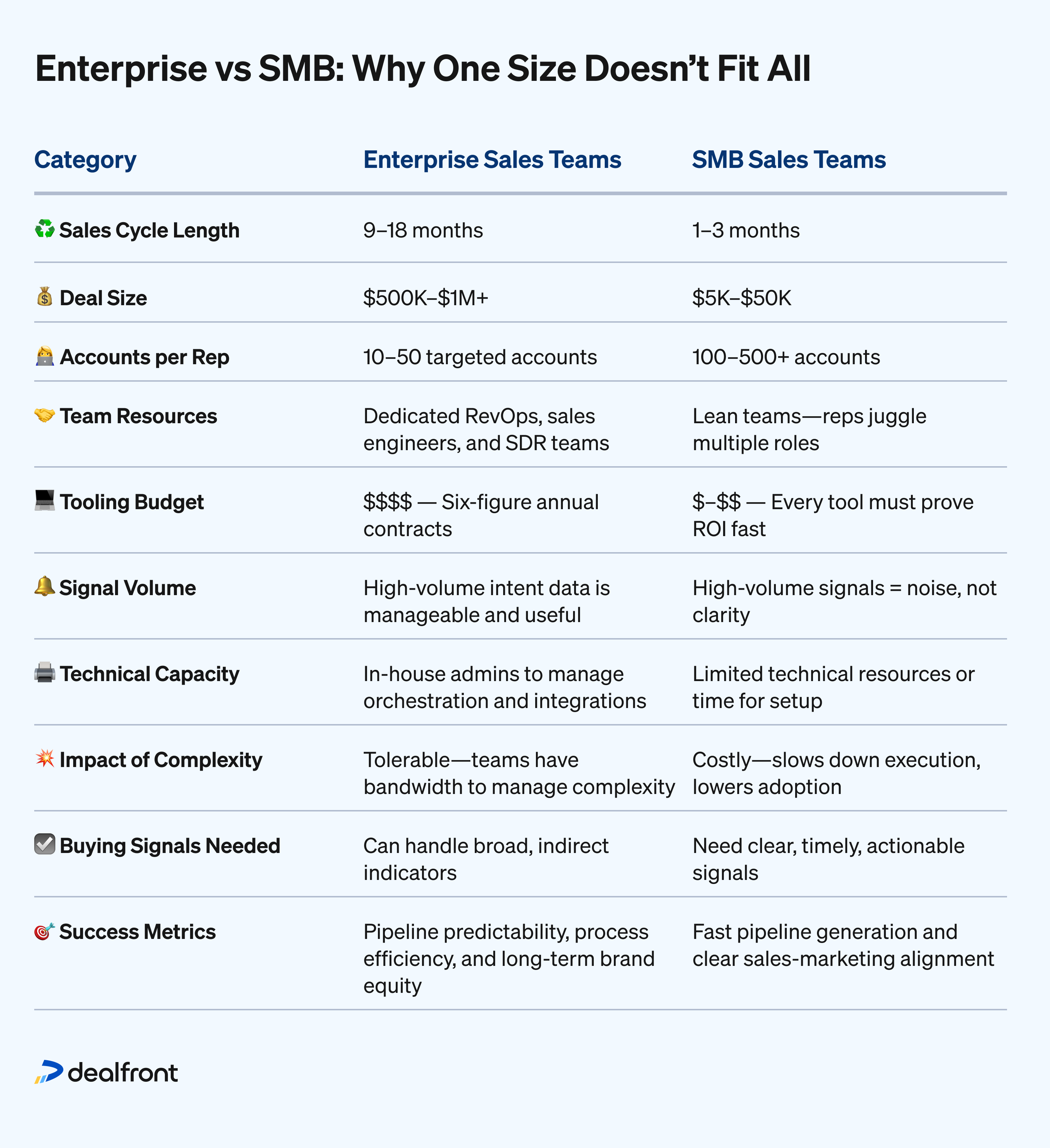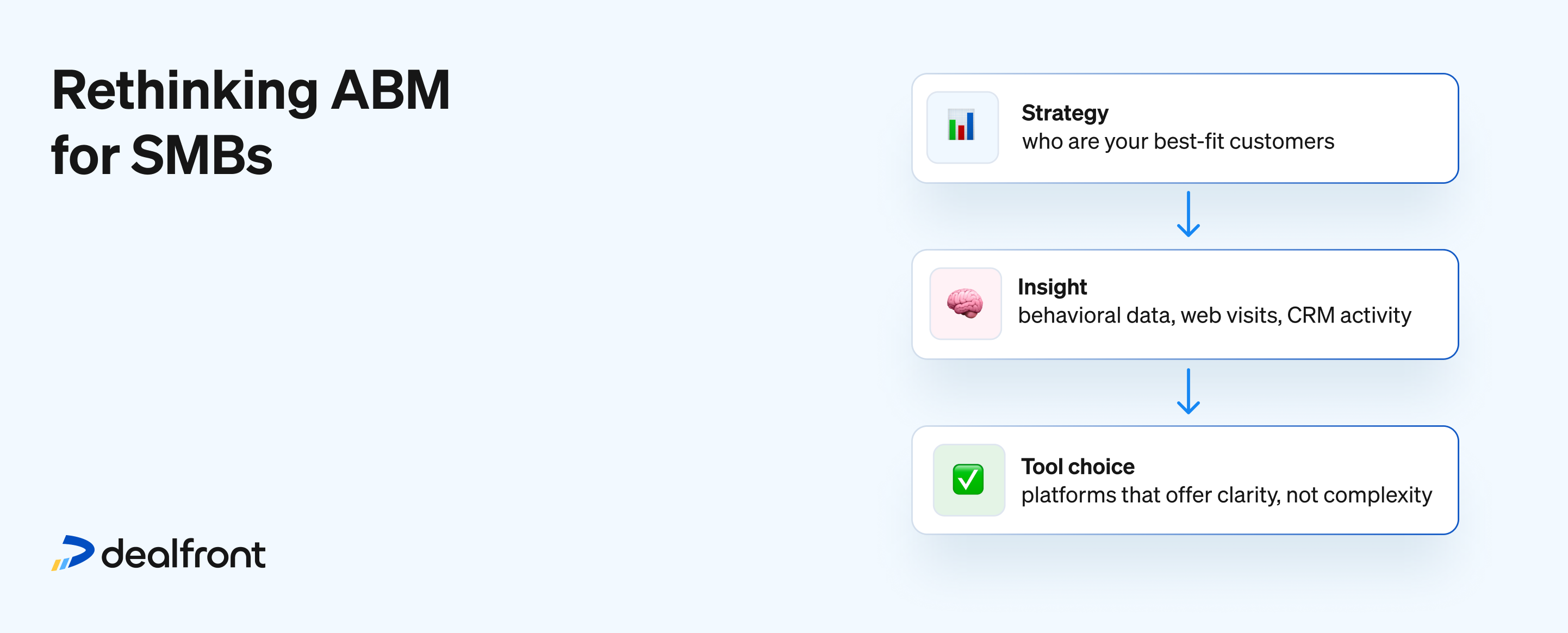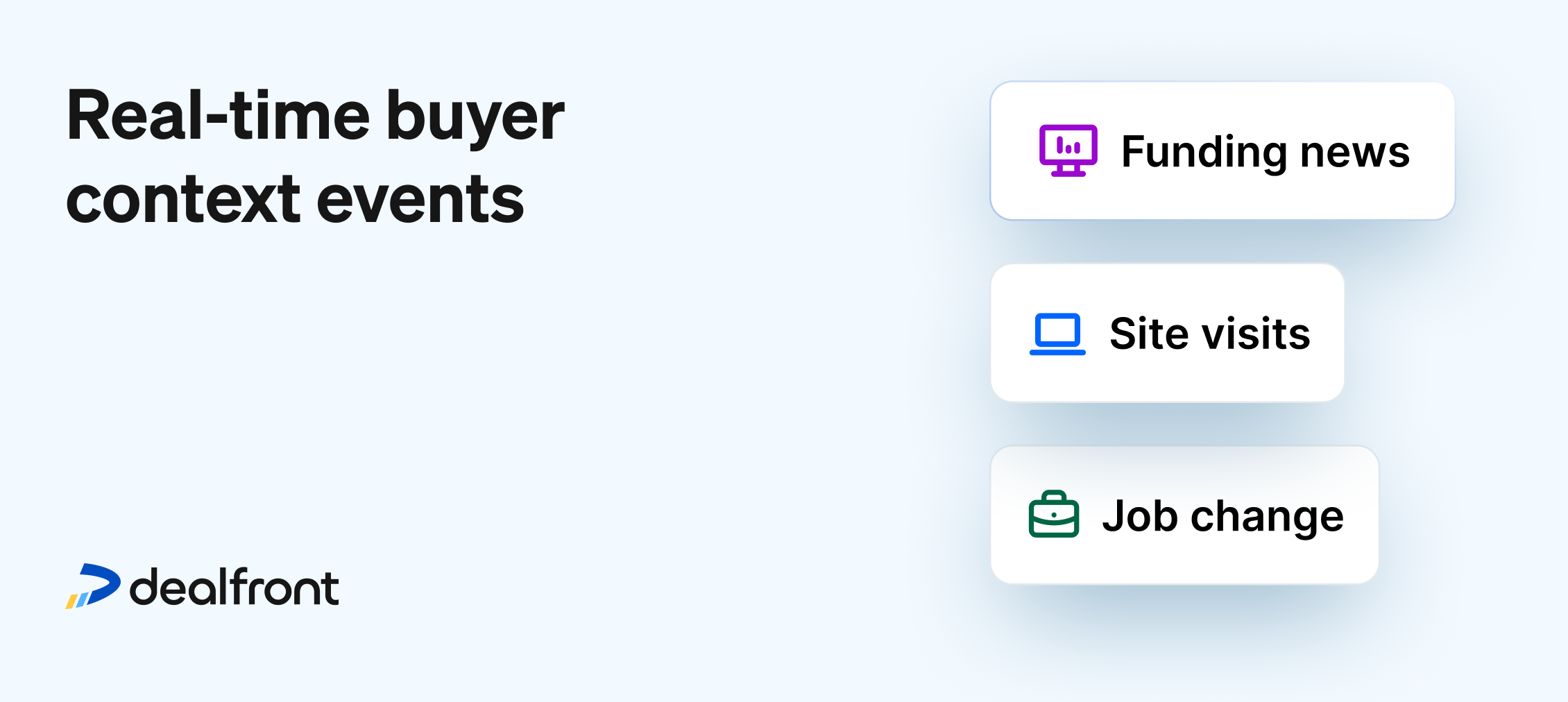Real-time intent signals, predictive scoring, automated orchestration; the demos were polished, the promises bold. The idea was simple and seductive: plug into a cutting-edge platform, and your pipeline would start filling itself.
For enterprise companies, chasing million-dollar deals with sprawling sales teams, some of these promises held true. But for small and mid-sized businesses (SMBs), the reality looked very different.
Instead of accelerating growth, many teams found themselves stuck. Overwhelmed by floods of confusing signals, struggling to justify complex workflows, and watching sales and marketing drift further apart, not closer together.
This isn’t just anecdotal. Forrester's research indicates that 35% of CMOs at emerging companies identify generating high-quality leads as a significant challenge, surpassing concerns like reduced budgets and prioritizing growth opportunities.
The problem isn’t account-based marketing (ABM) itself. ABM, when done right, is one of the most powerful ways to grow. The problem is that the tools, and the playbooks they enforced, were designed for a different kind of company, with a very different sales motion.
In this article, we’ll explore how enterprise sales technology broke the SMB pipeline, and why the future will belong to teams who strip away the noise, refocus on what actually drives the pipeline, and choose tools that work for them, not against them.
The promise of enterprise tools
It’s easy to understand why enterprise sales platforms became so appealing. Automation, predictive scoring, real-time intent signals—the pitch was irresistible. In a world where marketing teams are under constant pressure to do more with less, the idea of a single platform that could simplify everything, find your next customer, and fill your pipeline all in one fell swoop, was almost too good to pass up.
Enterprise-grade platforms promised exactly that: a silver bullet solution. With the right data and technology, they claimed, you could automate outreach, predict buying intent before a prospect even filled out a form, and orchestrate your entire go-to-market motion without missing a beat. No more manual lead scoring. No more guesswork about who to target. Just plug in, and let the machine drive.
For marketers overwhelmed by endless KPIs, think pipeline targets, lead quotas, attribution metrics, the narrative was also magnetic. As buyer journeys became more complex and as traditional inbound strategies showed more signs of fatigue, many teams felt they had no choice but to modernize. According to HubSpot's 2024 State of Marketing Report, over 41% of marketers measure the success of their content marketing strategy through sales, highlighting the increasing emphasis on revenue and pipeline performance.
There was also growing pressure to justify marketing’s contribution to revenue. CMOs needed better visibility into what was working (and what wasn’t). Sales teams demanded "hot" leads, not just brand awareness. Boards wanted proof that marketing investments were delivering returns. On paper, these enterprise tools seemed to answer all of those needs at once. They didn’t just promise better marketing, they promised measurable, predictable growth. The future of go-to-market, it seemed, was just a software subscription away.
But as many SMB teams would soon discover, the reality behind that silver bullet was far more complicated.
Why enterprise sales tools fail SMBs
For large enterprises targeting a small number of high-value accounts, enterprise sales platforms can be incredibly effective. When you’re pursuing a handful of $1M+ deals over 12-month sales cycles, the investment in real-time intent signals, predictive scoring models, and automated orchestration often pays off. There’s budget to burn, time to tune the systems, and dedicated operations teams to keep the whole thing running.
But when small and mid-sized businesses (SMBs) try to apply that same model, the cracks start to show.
SMB sales teams face a different reality than their enterprise counterparts. They can't afford to wade through a deluge of daily intent or buying signals. With most reps managing hundreds of accounts, alerts like "researching cybersecurity" or "visited your homepage" become more of a distraction than a valuable insight. This overload often leads to sales teams disregarding the data altogether or, even worse, chasing leads that ultimately go nowhere.
Compounding this issue is the reliance of many enterprise tools on third-party intent data. This often includes anonymous cookie behavior, broad topic interest, or signals from partner networks. The crucial element of context and clear buying signals is frequently missing and, as a result, marketing teams inadvertently pass along "hot leads" that lack any genuine potential. This creates a damaging disconnect, eroding trust between sales and marketing, and leading to frustration and stalled pipeline growth.
Turn anonymous website traffic into leads
Reveal which companies are already looking at your website and identify accounts that need your solution.
Start Discovering NowBut the misfit for SMBs doesn’t stop there. The "automation" promised by these platforms often morphs into a significant operational burden. These systems demand intricate integrations, continuous adjustments, and a level of technical expertise that most SMB teams simply don't have at their size. For lean revenue teams, the upkeep of these complex tools diverts precious time and resources away from the core task of generating pipeline.
Finally, the cost factor can’t be ignored. Many enterprise platforms come with a six-figure starting price tag, and that's before factoring in implementation and onboarding expenses. For SMBs, this represents a substantial investment in tools that frequently deliver limited and indirect returns. When teams struggle to demonstrate tangible value quickly, the platform becomes an unwanted and expensive overhead.
So essentially, what was supposed to simplify sales and marketing alignment has ended up adding friction, confusion, and has slowed processes up even more. The problem isn’t with the tools, they’re not broken, but they weren’t ever built for SMBs in the first place.
Account-based marketing was supposed to bring sales and marketing together, aligned around a shared target account list, coordinated outreach, and a focused path to revenue. But somewhere along the way, the strategy got swallowed by the technology meant to support it. For many small and mid-sized teams, the promise of ABM quickly turned into pipeline paralysis.
The root of the problem was that ABM stopped being a go-to-market strategy and became a checklist of tools. Want to do ABM? Buy a platform, plug it in, and watch the pipeline grow… at least, that’s how the pitch went. But real success never comes from software alone; it comes from strategy, process, and execution. And when those are missing, no tech stack, no matter how advanced, can save you.
It's easy to see how sales teams can get lost in the weeds with so many dashboards, alerts, and those "intent" scores that don't really tell you what a buyer is actually going to do. Meanwhile, marketing teams are under pressure to prove their worth and show some quick wins, so they sometimes focus on metrics and third-party data that look great in a presentation but don't lead to actual sales. The result is a lot of noise, not clear insights, and unfortunately, a drop in the quality of leads, which is a real worry as it damages the trust between sales and marketing.
When salespeople start to doubt the information they're getting, they understandably stop relying on it. And when marketers are more focused on the ins and outs of the tools rather than connecting with customers, they can lose sight of what really brings in revenue. This leads to targeting that's all over the place, processes that don't make sense, and a pipeline that might look promising on the surface but doesn't actually generate the results you need; a frustrating situation for everyone involved.
The Pipeline360 report highlights that 44% of B2B marketers identify problems with marketing/sales alignment as a chief barrier to achieving desired outcomes. That’s not a coincidence. When technology takes the lead without a clear GTM foundation, it drives teams further apart instead of bringing them together. The simple truth is this: ABM hasn’t failed, but how it’s been implemented, especially in the SMB space, has. Overengineered platforms created more friction than focus. And without the budget or bandwidth to keep tuning the machine, most teams ended up with less clarity, not more.
Rethinking ABM for SMBs
While account-based marketing itself isn't flawed, its presentation, sales approach, and implementation often fail, particularly for SMBs. ABM has frequently devolved from a strategic go-to-market approach into simply another element of a marketing technology stack. Although platforms offer appealing features like automated outreach, predictive intent buying signals, and AI-driven scoring, these powerful tools were designed for enterprise sales, where substantial deals support lengthy orchestration, numerous stakeholders, and specialized operations teams. This enterprise-focused model typically doesn't align with the practicalities of SMB sales.
Smaller teams need speed, not scale. They need insights they can act on today, not three weeks after a signal surfaces. And most importantly, they need tech that supports their process, not replaces it.
When ABM becomes synonymous with enterprise software, the strategy gets diluted. But strip back the tech, and the fundamentals still hold true: focusing your efforts on high-potential accounts, aligning your team around shared goals, and delivering value with precision. That’s not just an enterprise playbook, that’s good marketing.
According to a 2021 benchmark study by the ABM Leadership Alliance and ITSMA, 76% of marketers said ABM delivers a higher ROI than any other marketing strategy. The strategy works, it just needs to be right-sized.
For SMBs, this means:
Start with strategy - consider who are your best-fit customers, what do they care about, and where can you win?
Use insight to drive execution - behavioral data, web visits, CRM activity. These are the buying signals that tell you who’s active and ready to talk.
Choose tools that fit your team - look for platforms that offer clarity, not complexity. Ones that integrate easily, provide meaningful context, and don’t demand a six-month implementation plan.
The evolution of ABM points not to a decrease in technology, but rather to a more strategically aligned approach. The key lies in prioritizing strategy, with software serving as a supporting element.
What SMBs really need from sales tools (and what they’ve been missing)
While enterprise sales tools promised scale, what SMBs actually need is clarity. The high-volume, high-cost logic of enterprise go-to-market models doesn’t translate to the fast-moving, resource-constrained reality of small and mid-sized businesses. For SMBs, the goal isn’t more data, it’s the right data, delivered at the right time.
Precision over volume
Too many signals don’t equal smarter selling. In fact, they often lead to decision-fatigue. SMBs need fewer, clearer signals, ones tied to real buyer behavior. Think: repeat visits to high-intent pages, clear engagement trends, or firmographic changes that indicate a shift in need. This kind of intelligence empowers sales teams to focus, not flail.
This focused approach helps SMBs maximize their limited resources and avoid the pitfalls of chasing irrelevant leads generated by overly broad enterprise tools. By prioritizing quality over quantity in their data, SMBs can build a more efficient and effective sales pipeline.
Real-time buyer context
A job change, a new funding round, or a sudden spike in product page views—these are the moments that matter. Intent signals from a third-party cookie two weeks ago is too little, too late. SMB sales cycles are short, and teams need insights they can act on now, not later.
These real-time shifts provide clear, actionable intelligence that directly informs outreach and engagement strategies. SMBs thrive on agility, and timely data points like these enable and empower them to connect with prospects at the peak of their interest and need.
Sales and marketing, in sync
Genuine go-to-market alignment goes beyond simply handing off leads. It necessitates common objectives, unified data, and collective accountability for revenue results. Achieving this collaborative partnership means tools designed to foster teamwork, moving beyond mere lead scoring systems and Marketing Qualified Leads, are essential.
This collaborative environment fosters a more unified approach to the market, breaking down silos and ensuring that both sales and marketing teams are working towards the same objectives with a consistent understanding of the customer. By focusing on shared metrics and a joint responsibility for results, companies can build a more effective and sustainable pipeline.
Technology that fits the model
SMBs can’t afford lengthy implementation and optimization processes for complex platforms. They need user-friendly tools that are simple to deploy and primarily focused on pipeline generation, rather than intricate process management. Tools like Dealfront provide this necessary agility by offering buyer signals, website intelligence, and CRM-integrated data that aligns with SMB workflows, prioritizing their needs over rigid system requirements.
Essentially, SMBs don’t need scaled-down enterprise ABM tools. They need a properly sized, data-driven strategy that connects them to real buyers, in real time, with real revenue outcomes. This is the key to getting the pipeline moving again.
The future of SMB sales tech
The future of SMB sales isn’t less technology, but better technology, used more strategically. AI, automation, and real-time data will continue to shape how go-to-market teams operate, but the winners in the next era won’t be those chasing the most signals. They’ll be the ones who know what matters and how to act on it.
Over the last few years, many SMBs were sold a vision of growth powered by enterprise-grade systems: automate everything, score every lead, scale every workflow. But what’s become clear is that success doesn’t come from plugging in another dashboard. It comes from understanding your buyers deeply and using technology to meet them with context, relevance, and timing. The promise of automated growth and a self-filling pipeline proved tempting, but the reality for many SMBs was quite different. Instead of streamlined efficiency, they encountered complexity and diminishing returns, highlighting a fundamental mismatch between enterprise-grade solutions and the needs of smaller businesses.
Used well, AI can surface patterns faster. Automation can reduce manual effort. But no tool can replace a team that knows how to spot buying signals, interpret them in context, and act with purpose. The future is data-driven, but decisively human-led.
The next generation of sales tools for SMBs won’t be bloated platforms built for Fortune 500 org charts. They’ll be streamlined, flexible systems that deliver the essentials—clean data, clear signals, real-time buyer context. Tools that are intuitive to adopt, easy to align around, and directly tied to pipeline creation.
Account-based strategy still matters—but not when it’s confused with a tool category. When ABM is rooted in shared goals, focused targeting, and insights that sellers trust, it works. The challenge—and the opportunity—is building the right foundation: aligning your team, defining your motion, and using tools that support the way you sell.
In short, SMBs don’t need more tech. They need smarter tech. Purpose-built platforms that power a modern, data-aware, human-led GTM motion, without overwhelming the people trying to run it. The future won’t be led by whoever has the most data, but by those who can make the clearest sense of it.
Remember
Enterprise tools promised a revolution, but for SMBs, they often delivered confusion, complexity, and cost. Instead of solving for pipeline performance, they introduced friction. Instead of enabling alignment, they widened the gap between sales and marketing. The key problem is simple though; these platforms were built for someone else’s go-to-market.
But there is good news: ABM isn’t broken, it’s just been misapplied. When grounded in real buyer behavior, shared goals, and right-sized tools, account-based strategy still works. In fact, for many SMBs, it’s still the most efficient path to growth. The path forward isn’t about giving up on technology. It’s about making it work for your motion. SMBs need tools that reflect the speed, focus, and reality of how they actually sell. Simple, scalable platforms that empower sellers, support strategy, and generate outcomes, not dashboards.
So if you’re an SMB marketer, founder, or sales leader, ask yourself:
Do our tools help us move faster, or slow us down?
Are we working from real signals, or just noise?
Is our strategy clear, or buried under complexity?
Are sales and marketing genuinely aligned, or just sharing a dashboard?
Is our tech stack serving our team or are we serving the stack?
Are we making decisions based on buyer behavior or based on what the platform tells us?
If your current B2B sales approach creates more uncertainty than assurance, a new direction might be just what you need. The future of B2B sales for smaller businesses isn't about applying enterprise strategies. Instead, it's intelligent, relies on data, and prioritizes human connection, aligning with your actual growth patterns.
